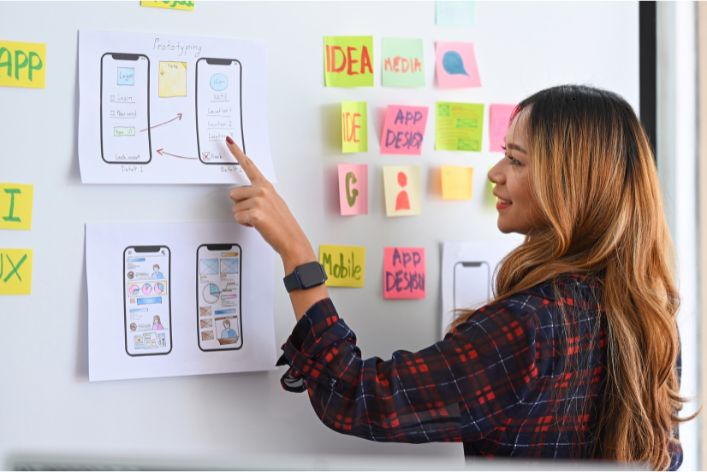A prototype and MVP are two core terminologies in software development.
If you develop software, you know there are many steps to complete before releasing the final product.
You must choose the appropriate development technique.
You must also validate your business idea.
Product validation helps your software succeed.
It questions assumptions, shows market needs, and establishes a clear course for development.
IT organizations often use a prototype and an MVP.
These determine if target customers and stakeholders will accept their business concept.
While these terms may seem similar, they have very different meanings and uses.
In this post, we will examine the differences between prototypes and MVPs.
We will also explore when to use each one.
What is a Prototype?
A prototype can range from low-resolution sketches on paper to a high-fidelity, clickable, mobile-compatible digital model.
It can show a single crucial screen, a complicated workflow, or all of the essential elements of an app.
And either code or no code can be used to make it.
A prototype’s objective is to depict and show how an app’s basic structure and features work without actually functioning.
In order to obtain feedback from actual users, it is frequently utilised in conjunction with user interviews.
There are several different types of prototypes, including:
- Concept prototypes: These are used to test the feasibility of a product idea and to validate the market need. They are often simple sketches or mock-ups that demonstrate the basic concept of the product.
- Functional prototypes: These are used to test the product’s functionality and to gather feedback on the user experience. They may be more advanced than concept prototypes and may include some basic functionality.
- Visual prototypes: These are used to test the product’s design and aesthetic. They may include detailed mock-ups of the product’s appearance to gather feedback on its look and feel.
Advantages of Using a Prototype
- Allows for early testing and validation of a product idea: A prototype allows for early testing and validation of a product idea. You can test the feasibility and gather feedback on its design and functionality. This can help you identify potential issues early on and make changes before the final product is developed.
- Helps identify potential design or functional issues: By creating a prototype, you can identify potential design or functional issues. This helps you make changes before developing the final product, saving time and money.
- Provides an opportunity for gathering feedback from potential customers or users: A prototype provides an opportunity to gather feedback from potential customers or users. This helps you understand their needs and preferences. It can also inform the design and development of the final product, making it more likely to be successful.
- Allows for rapid iteration and improvements to the product: Prototyping allows for rapid iteration and improvements. You can quickly test and enhance the product. This can help you get to market faster and increase your chances of success.
- Cost-effective: Creating a prototype is often less expensive than developing the final product. This allows you to test and validate product ideas before investing a lot of resources into the final product.
- Helps testing and experimenting: Creating a prototype allows you to experiment with different designs and features. This helps you make better-informed decisions about the final product.

What is an MVP?
A minimal viable product, also known as an MVP, is the most basic or scaled-down version of your programme.
It is made available to the public in order to solicit feedback from your initial user base.
An MVP does not have any bells and whistles and instead concentrates only on the essential functions that add value.
An MVP is similar to a prototype but has minimal capabilities.
It is released to a select group of beta users or the general public.
This approach gathers user input on your app and provides insights on usage that prototypes can’t reveal in interviews.
In fact, the adventures of many popular apps of today began as MVPs.
They underwent considerable modifications, executed successful pivots, and arrived at their current location only after going on sale.
Read more: “Minimum Viable Product” or MVP and Its Types
Advantages of using an MVP
- Provides valuable feedback for further development: An MVP allows you to gather feedback from real customers, which can inform the development of the final product. This can help you create a product that better meets the needs of your target market.
- Allows for early validation of the product idea with real customers: By releasing an MVP, you can validate your product idea with real customers and gather valuable feedback. This can help you make better-informed decisions about the final product.
- Helps identify which features are truly necessary: An MVP allows you to focus on the minimum set of features that are needed for customers to find value in the product. This can help you prioritize features and avoid wasting time and resources on unnecessary features.
- Allows for a faster time to market: An MVP can be released while work on the final product continues. This allows you to get to market faster and start generating revenue sooner.
- Low-risk: An MVP is a low-risk approach to product development, as it allows you to test the product idea and gather feedback before investing a lot of resources into the final product.
- A better understanding of the market: By releasing an MVP, you can get a better understanding of the market, the needs of your target customers, and what features are most important.
Read: What are the Top Funding Options for Startup Ventures?
Differences between Prototype and MVP
Functionality and Design
A prototype is typically a simplified version of the final product, and may not include all the features or functionality of the final product.
It is often used to test and demonstrate key features, design, and functionality.
An MVP, on the other hand, is a “working” product that includes the minimum set of features necessary for early customers to find value in it.
The MVP is intended to be a functional product with the minimum set of features to validate the product idea and gather valuable feedback.
Development and Testing
A prototype is often used to gather feedback on the design or functionality of a product and is not intended for use by customers.
It is used to identify potential issues and make improvements before the final product is developed.
An MVP, on the other hand, is intended for use by early customers and is designed to gather valuable feedback for further development.
An MVP is a fully functional product that is released to early customers for feedback and testing.
We Design & Develop Websites, Android & iOS Apps
Looking to transform your digital presence? We specialize in creating stunning websites and powerful mobile apps for Android and iOS. Let us bring your vision to life with innovative, tailored solutions!
Get Started TodayCost and Time
Developing a prototype can be relatively inexpensive and can be done quickly.
It is a cost-effective way to test and validate product ideas before investing a lot of resources into the final product.
An MVP, however, is intended to be a “working” product and may require a significant investment of time and resources to develop.
An MVP is a more expensive approach to product development as it is intended to be a functional product that customers can use.
Risk
Prototypes are low-risk as they allow you to test and validate product ideas before investing a lot of resources into the final product.
An MVP, however, is a higher-risk approach to product development as it is a “working” product that is intended for use by real customers.
Read: How to Build a Minimum Viable Product (MVP) for a Startup?

How To Know When to Create a Prototype vs an MVP?
The biggest mistake that can be made is producing the incorrect item at the incorrect time.
The most annoying aspect of any project is time wastage.
When deciding whether to build a prototype or an MVP, consider the following two questions:
1. Have you already validated that the problem you’re trying to solve exists?
If the answer to this question is “no,” you should first think about doing user interviews, and if a visual aid is useful for your idea, you should build a prototype to utilise in those interviews.
Make sure this is a problem people have and that your solution is what they’ve been looking for before you start creating anything.
2. Have you already gotten feedback on the design of your solution?
If the answer to this question is “no,” you might want to think about using the design mockups you already have and a prototyping solution like InVision Cloud to create a clickable prototype so you can perform a round of usability interviews.
A usability interview is comparable to a user interview in that it aims to ascertain whether people find your software simple to use and navigate.
If your answer to both questions is yes, then you’re ready to create an MVP because creating an MVP doesn’t break the bank or take forever to build.
Conclusion
Prototypes and MVPs are two important tools in the product development process.
Both are used to test and validate product ideas but have different purposes and uses.
A prototype is a preliminary version of a product that is used to test and demonstrate key features, design, and functionality, while an MVP is a version of a product that has the minimum set of features necessary to satisfy early customers and gather valuable feedback for further development.
Understanding the differences between prototypes and MVPs and when to use each one is essential for successful product development.
Before you go…
Hey, thank you for reading this blog to the end. I hope it was helpful. Let me tell you a little bit about Nicholas Idoko Technologies.
We help businesses and companies build an online presence by developing web, mobile, desktop, and blockchain applications.
We also help aspiring software developers and programmers learn the skills they need to have a successful career.
Take your first step to becoming a programming boss by joining our Learn To Code academy today!
Be sure to contact us if you need more information or have any questions! We are readily available.
Put Your Tech Company on the Map!
Get featured on Nicholas Idoko’s Blog for just $200. Showcase your business, boost credibility, and reach a growing audience eager for tech solutions.
Publish Now










